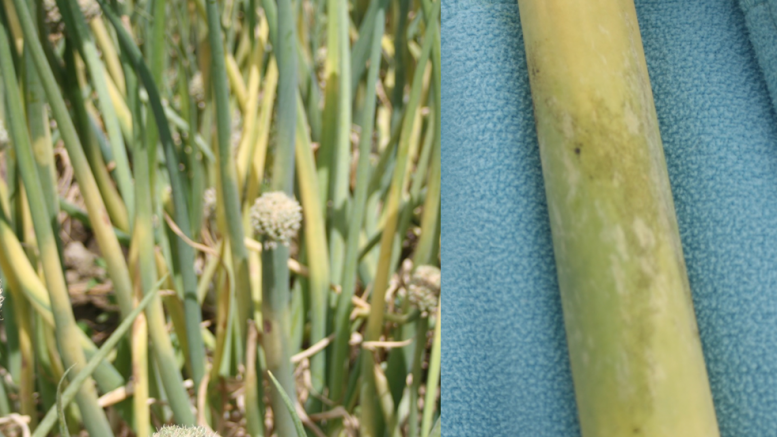The WSU Extension office reports that downy mildew has been reported in a couple of onion seed fields in the Columbia Basin between Moses Lake and Eltopia. Weather is a major driver of downy mildew pressure. A mild winter and periodic cloudy and rainy conditions has allowed the disease to develop and spread. Downy mildew is facilitated by cool (<75 degrees F), moist conditions.
WSU urges onion growers to scout onion seed and bulb crops regularly for symptoms of downy mildew and to take appropriate precautions. Management recommendations are listed below. If you find downy mildew, please send an email to let WSU know (cwohleb@wsu.edu or twaters@wsu.edu).
This is not a new disease for the Basin. It has been seen in other years too, but usually in a limited number of fields. In 2016 and 2017, downy mildew was found in a few onion seed crops in the late Spring and then in onion bulb crops in the Summer.
SYMPTOMS: Symptoms first appear as pale-green to yellow lesions on leaves and/or on seed stalks. A gray or purplish-gray, fuzzy growth may develop on the lesions; these are the fruiting bodies (sporangiophores) and spores of the pathogen. Severely affected leaves and seed stalks may collapse. Downy mildew is sometimes misdiagnosed because the lesions are commonly colonized by Stemphylium vesicarium, the opportunistic fungus that causes Stemphylium leaf blight.
DOWNY MILDEW MANAGEMENT:
- Avoid excessive irrigation. Overhead irrigation favors downy mildew.
- If possible, plant in the direction of prevailing winds to facilitate airflow through the canopy and avoid dense plantings.
- Plant pathogen-free transplants, sets, and seed. Use a seed treatment (like Apron).
- Scout fields often to be ready to implement management strategies before excessive spread occurs.
- Foliar fungicide sprays are only effective when appropriate products are applied in a timely manner with good coverage. Note that Peronospora destructor (the causal agent of downy mildew) is not a true fungus (it is an oomycete). Growers often focus their fungicide spray program on Stemphylium leaf blight (caused by a fungal pathogen) using strobilurin fungicides (like Quadris), but that will not manage the downy mildew. Effective fungicides registered in Washington for onion downy mildew include: Tanos (cymoxanil + famoxadone = FRAC 11 + 27), Forum (dimethomorph = FRAC 40), Reason (fenamidone = FRAC 11), Revus (mandipropamid = FRAC 40), and mefenoxam formulations like Metalaxyl 4.0 ST, Ridomil Gold Copper (mefenoxam + copper hydroxide = FRAC 4). It is really important to rotate fungicide modes of action, because this pathogen can readily develop resistance to fungicides. Pay attention to the FRAC group, often listed on product labels, because they help you know which products share similar modes of action (FRAC = Fungicide Resistance Action Committee). It is best to rotate products with different FRAC groups with every single spray.
- Organic onion growers can apply OMRI approved copper formulations, but they will only provide limited control.
- Destroy infested crop residues after harvest, and erradicate volunteer onions.
- Practice a 3-year or longer crop rotation.
More information on onion downy mildew can be found in the PNW Disease Handbook and there are several good images of disease symptoms on the PNW Veg Extension Group photo gallery. Most of the information presented above was sourced from the writings and presentations of Dr. Lindsey du Toit, WSU Plant Pathologist.
SOURCE: Washington State University Extension


